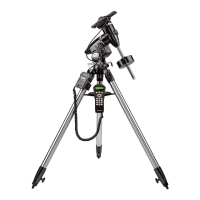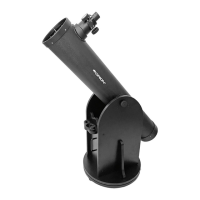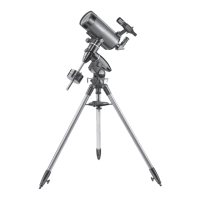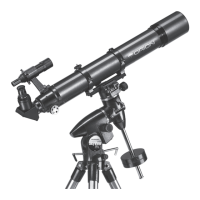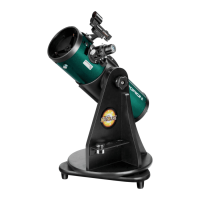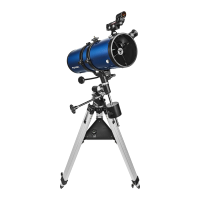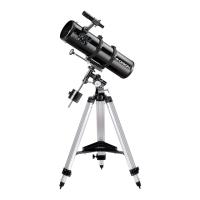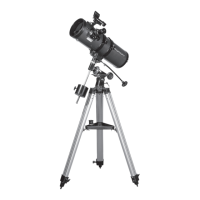12
Europa, and Ganymede. Higher power eyepieces should bring
out the cloud bands on the planet’s disk.
Saturn: The ringed planet is a breathtaking sight. The tilt angle
of the rings varies over a period of many years; sometimes
they are seen edge-on, while at other times they are broad-
side and look like giant “ears” on each side of Saturn’s disk. A
steady atmosphere (good seeing conditions) is necessary for
a good view. Look closely and you may see the Cassini divi-
sion, a thin, dark gap in the rings. You should also see one or
more of Saturn’s moons, which look like faint nearby stars. The
brightest is the moon Titan.
Venus: At its brightest, Venus is the most luminous object in
the sky, excluding the Sun and the Moon. It is so bright that
sometimes it is visible to the naked eye during full daylight!
Ironically, Venus appears as a thin crescent, not a full disk,
when at its peak brightness. Because it is so close to the Sun,
it never wanders too far from the morning or evening horizon.
No surface markings can be seen on Venus, which is always
shrouded in dense clouds.
Mars: The Red Planet makes a close approach to Earth every
two years. Observing Mars is most favorable at these times.
You should see a salmon-colored disk with some distinct dark
patches, and you may be able to spot a whitish polar ice cap.
To see surface detail on Mars, you will need a high power eye-
piece and very steady air!
C. The Sun
You can change your nighttime telescope into a daytime Sun
viewer by installing an optional full-aperture solar lter over the
front opening of the telescope. The primary attraction is sun-
spots, which change shape, appearance, and location daily.
Sunspots are directly related to magnetic activity in the Sun.
Many observers like to make drawings of sunspots to monitor
how the Sun is changing from day to day.
Important Note: Do not look at the Sun with any opti-
cal instrument without a professionally made solar lter
placed over the front aperture of your telescope, or perma-
nent eye damage could result.
D. The Stars
Stars will appear like twinkling points of light. Even powerful
telescopes cannot magnify stars to appear as more than a
point of light. You can, however, enjoy the different colors of
the stars and locate many pretty double and multiple stars. The
famous “Double-Double” in the constellation Lyra and the gor-
geous two-color double star Albireo in Cygnus are favorites.
Defocusing a star slightly can help bring out its color.
E. Deep-Sky Objects
Under dark skies, you can observe a wealth of fascinating
deep-sky objects, including gaseous nebulas, open and globu-
lar star clusters, and different types of galaxies. Most deep-sky
objects are very faint, so it is important you nd an observing
site well away from light pollution.
To nd deep-sky objects with your telescope, you rst need
to become reasonably familiar with the night sky. Unless you
know how to recognize the constellation Orion, for instance,
you won’t have much luck locating the Orion Nebula. A simple
planisphere, or star wheel, can be a valuable tool for learning
the constellations and seeing which ones are visible in the sky
on a given night. Once you have identied a few constellations,
a good star chart, atlas, or astronomy app will come in handy
for helping locate interesting deep-sky objects to view within
the constellations.
5. Collimation of the Optics
Collimation is the process of adjusting the optics of a tele-
scope so they are precisely aligned with one another and with
the telescope tube. For this Dobsonian telescope, the primary
and secondary mirrors must be in precise alignment. Your tele-
scope’s optics were aligned at the factory, and should not need
much adjustment unless the telescope is handled roughly.
Accurate mirror alignment is important to ensure the sharpest
possible images viewed through your telescope, so it should
be checked occasionally. With practice, collimating is relatively
easy to do and can be done in daylight.
It helps to perform the collimation procedure in a brightly lit
room with the telescope pointed toward a bright surface, such
as a light-colored wall. The telescope tube should be oriented
horizontally (parallel to the ground). Placing a piece of white
paper in the telescope tube opposite the focuser (i.e., on the
other side of the secondary mirror from the focuser) will also
be helpful (see Figure 16). You will need the included 2mm
hex key (R) to perform the collimation.
To check your telescope’s collimation, remove the eyepiece and
look down the focuser. You should see the secondary mirror
centered in the focuser, as well as the reection of the primary
mirror centered in the secondary mirror, and the reection of the
secondary mirror (and your eye) centered in the reection of the
primary mirror, as in Figure 17A. Got all that? Review it again
carefully, and compare what you see to Figure 17. If anything
is off-center, proceed with the following collimation procedure.
Figure 16. Before collimating the telescope, place a piece
of white paper inside the tube opposite the focuser, and
position the optical tube in the horizontal position as shown.
